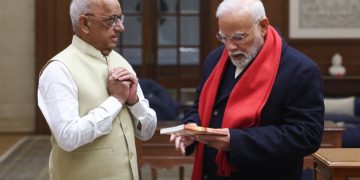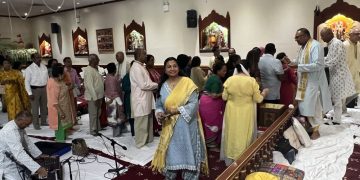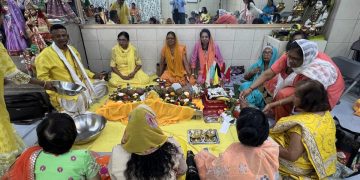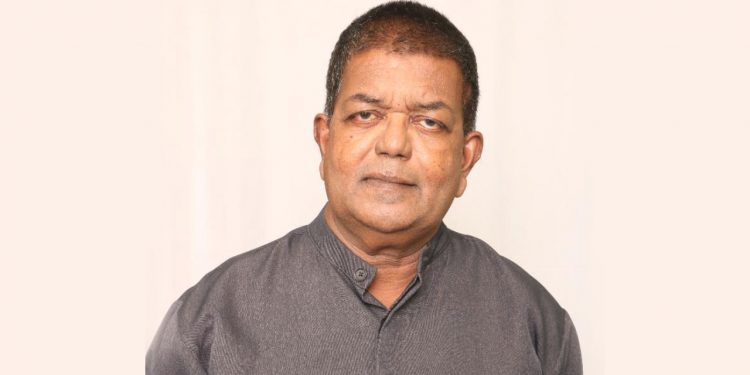I was happy to learn that the Ganesh Mandir of Suchit Trace, Penal is celebrating its 107th Annual Ganesh Utsav Festival to commemorate the birth of Lord Ganesh. More interestingly, at Ramai Trace, the temple is celebrating its 112th Annual Ganesh Utsav. This is certainly a record not only for the people of Penal to be proud of but the entire Hindu diaspora!
I want to thank Gowtam Maharaj of Barrackpore for inviting ICDN to cover this unique aspect of our cultural and religious history. I was introduced to Anirudh Boodram, President of the Ganesh Mandir, who informed me that he was the 4th generation in his family to be engaged in the celebration of Ganesh Utsav.
A definite livewire was Satnarine Maharaj. When I arrived, he was cleaning the altar by removing the old flowers and garlands and bathing the murtis before proceeding to dress them and offer fresh garlands. Describing himself as the naw or assistant to the pandit, Satnarine Maharaj displayed a sense of Hindu pride in what he was doing.
The temple was a beehive of activities with many devotees engaged in the preparation of meals since this being the second to last night of the Ganesh Utsav. Kawal Boodram was busy kneading flour in a huge pot while Ricky Mathura, described as the ‘sakeh man,’ had positioned a huge tawa for the cooking of the roti. In another corner of the kitchen ladies were cooking tarkarie. A pot of dasheen bush bhaji was chowkayed, and Tanty Basso, turning the pot revealed to me that she has been engaged in the Utsav for the past 45 years. “I married and came to live in Suchit Trace, and this is 45 years I am helping in the kitchen.”
At the other section of the mandir more ladies were engaged in preparing vegetables for the meal. Speaking softly, they remained focus on the task before them. The serenity with which they work revealed to me that they were devotees offering their time and not paid workers.
Ganesh Utsav is a strictly religious activity, and nothing is done without the conduct of pooja. Fasting begins fifteen days before the digging of the dirt which is done 15 days before the start of the Utsav. Before the digging begins, pooja is done. At the site where the dirt is to be dug, permission must be sought from Mother Earth through another round of prayers. The transport of the dirt to the mandir for the construction of the Ganesh murti is another ritual and takes the form of a procession on foot with the dirt carried in trays on the heads of devotees.
The building of the Ganesh murti is done with clay and cotton. The cotton helps to bind the clay together. After the murthi is constructed, it is painted with ecofriendly paints by hand. On the day of the birthday or Utsav the murti is dressed and ornaments are used to decorate the body.
Devotees come every night to the mandir and listen to the pandit sharing episodes on the many exploits of Lord Ganesh from the Ganesh Purana. Lord Ganesh is also known as Vigneshwar or the remover of obstacles. Devotees know that whatever difficulties or challenges they are facing that Lord Ganesh would take them away.
Ganesh is a god that is known for bestowing blessings to his devotees for little in exchange. With ladoo being Lord Ganesh’s favourite sweet, devotees are told that by offering a few ladoos to Him, He would be so pleased and grant to them their desires.
On the final night of the festival devotees of the Ganesh Mandir of Suchit Trace take the murti in a huge procession to a pond near the site where the dirt was extracted and immersed the murti.
Ganesh Utsav became a huge public celebration in the late 19th century under the guidance of Bal Gangadhar Tilak in Maharashtra, India. Huge clay murtis of Lord Ganesh were made and installed in public places for worship during the ten-day festival. The festival served two other functions apart from religious sentiments. It helped to unite the fragmented Hindu community and provide a forum to rally the people against the British Raj.
Over the years, Ganesh Utsav has grown into a global Hindu movement. In Trinidad the festival has travelled form Penal to venues across the country. Tobago did not celebrate this year but had a proxy venue at the Rukminee Holass’ ranch in Caparo where the visarjan or immersion of the murti is taking place as I write.
The imagery of Ganesh and numerous stories and beautiful bhajans all combine to draw all to this festival. No less is the sharing of information in social media from the far corners of the world including Africa where devotees celebrate passionately this festival.
May Ganesh Baba continue to bless all.








































































